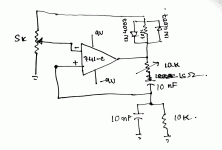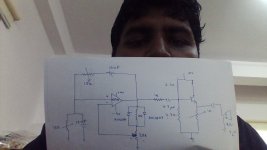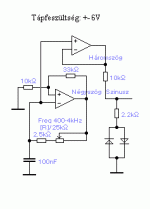I had been trying to build a variable wien bridge oscillator . The schematic is shown below - I wanted to change the frequency by using a pot . But it starts to distort after 12 Khz. Also when i am reducing both the capacitors to 1 nF I find the waveform to be triangular more than sinusoidal. Also if I want to drive 0.5 w 8 ohm ospeaker should i use an op amp or an lm386 ? Also how do i change the frequency with one control pin?
Attachments
You need a faster opamp than a 741 for high frequency use. The Wien bridge has two frequency determining networks and so normally you would use a dual gang pot.
Controlling an oscillator with a single input usually implies a 'voltage controlled oscillator' whose basic waveshape is often triangular. This is then shaped via a diode network to approximate a sine wave.
http://www.ti.com/sc/docs/apps/msp/journal/aug2000/aug_07.pdf
Controlling an oscillator with a single input usually implies a 'voltage controlled oscillator' whose basic waveshape is often triangular. This is then shaped via a diode network to approximate a sine wave.
http://www.ti.com/sc/docs/apps/msp/journal/aug2000/aug_07.pdf
I think you need something faster than a 741.
That is a classic sign of slew rate limiting... the opamp output can't keep up.Also when i am reducing both the capacitors to 1 nF I find the waveform to be triangular more than sinusoidal.
This may help :
'Oscillators with single-element frequency control'
Electronics World August 2004, pp36-37.
'Oscillators with single-element frequency control'
Electronics World August 2004, pp36-37.
Of course there are oscillators with 1 adjustment element, I designed one also, but not wien bridge. Not this simple or not low distortion.
in addition to the input from Mooly regarding the opamp speed vs quality of signal, you should also calculate the current needed to drive the load that you wish to drive; then look at the data sheet for the available output current from the opamp.
mlloyd1
mlloyd1
Of course there are oscillators with 1 adjustment element, I designed one also, but not wien bridge. Not this simple or not low distortion.
I had built the oscillator and now I want to drive it using a speaker . So i Had used an emitter follower . BUt somehow the speaker is giving a very reduced voice output. How do i increase the power more. Also can you give the schematic of your oscillator
Attachments
To drive a speaker you need WAY more current than what an emitter follower can supply.
Shortest path is to attenuate output signal and drive a chipamp, from LM386 to TDA 20xx to ....
Shortest path is to attenuate output signal and drive a chipamp, from LM386 to TDA 20xx to ....
The values of 10K and 10uF look like they are too much of a load for the opamp. I would go with something like 100k dual pot and 0.1uF.
Use a buffer amp for the speaker...LM386 or TDA2002, or similar.
Use a buffer amp for the speaker...LM386 or TDA2002, or similar.
I had built the oscillator and now I want to drive it using a speaker . So i Had used an emitter follower . BUt somehow the speaker is giving a very reduced voice output. How do i increase the power more. Also can you give the schematic of your oscillator
Attached a simple square+triangle+sine generator. The sine is very rough, THD is about 2...5%.
For higher power you can use any power amp IC, or if you like emitter follower, then it should be complementary, with a little higher quiescent current.
Attachments
Documents of interest:
http://www.sdiy.org/colbecklabs/spec_sheets/AN-263.pdf
ftp://ztchs.p.lodz.pl/PRP/PRP_2008_2009/LB-16.pdf
And in the context of speaker driver applications, this one too:
http://www.diyaudio.com/forums/chip-amps/254384-automatic-resonance-frequency-finder.html
http://www.sdiy.org/colbecklabs/spec_sheets/AN-263.pdf
ftp://ztchs.p.lodz.pl/PRP/PRP_2008_2009/LB-16.pdf
And in the context of speaker driver applications, this one too:
http://www.diyaudio.com/forums/chip-amps/254384-automatic-resonance-frequency-finder.html
- Status
- Not open for further replies.
- Home
- Amplifiers
- Solid State
- Creating a variable wien bridge oscillator


